Table of Contents
Introduction
Making business operations lean & efficient is essential in today’s business world. People spend a lot of effort and money trying to make their businesses more efficient.
Time is precious because when a business works well, it can do more in less time.
But did you know that many businesses in the US (around 75%!) have a big problem? Some employees are stealing time from work.
Recent studies highlight that over 81% of US companies suffer from various forms of time theft, including fraud, like embezzlement and occupational abuse.
This kind of theft happens when employees cheat their working hours, which can be a big deal. It’s like when someone steals money or things from a company.
At first, small things like adding extra time to work hours or punching in for friends might not seem like a big deal.
But billing for time you didn’t work is stealing money.
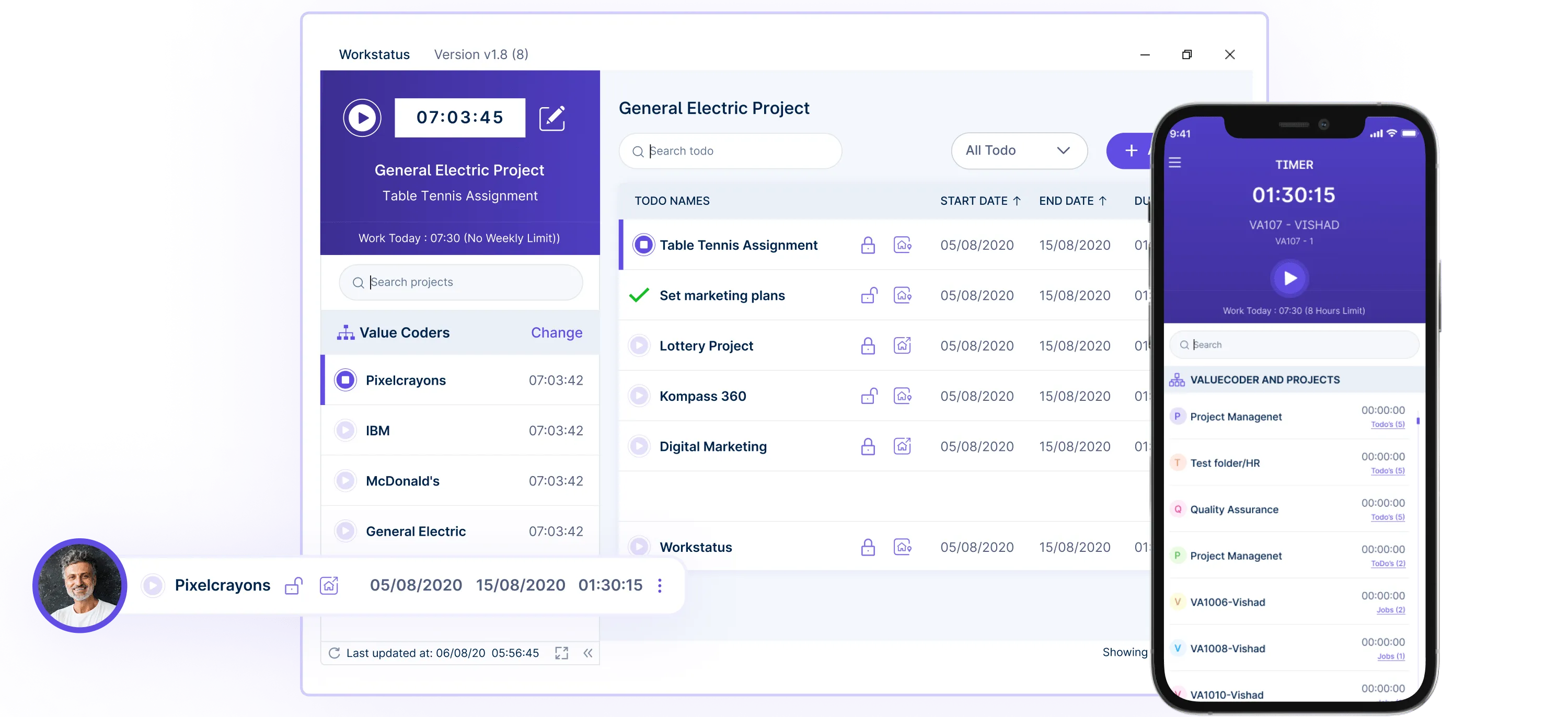
This blog post will tell you everything you need to know about what it means to steal time and what might happen if you get caught doing it.
What Is Time Theft?
Time theft occurs when employees misrepresent their working hours, either through deliberate falsification or through unproductive activities that go unnoticed. At the same time, it might seem like a minor issue, but the cumulative effect can devastate your software services business.
It can be small, like taking extra breaks or starting work late, or more serious, like faking hours on a timesheet.
Imagine being paid for doing a job while not doing it—that’s what time theft is.
Even though it might seem small, it can cause big problems for a company because it affects how much work gets done and the company’s trust in its employees.
What Is The Cost Of Time Theft?
The repercussions of time theft extend beyond mere clock hours lost within a company. Let us understand the true cost of time theft:
Reduced profitability: Every hour stolen translates to lost revenue and decreased profit margins.
Inaccurate project estimates: Inaccurate time tracking leads to unreliable project estimations, impacting client relationships and project success.
Unfair compensation: When employees are not compensated for their actual work hours, it can create resentment and demotivation within teams.
Management challenges: Time theft makes it difficult to track project progress and identify areas for improvement accurately.
Understanding Types Of Time Theft
Here are the different types of time theft
1. Unauthorized breaks
Unauthorized breaks occur when employees take longer breaks than allowed or without permission.
These breaks can be longer than what’s permitted by the company or occur more frequently than usual.
For example, an employee might take extended lunch breaks or leave the work area for personal reasons without letting their supervisors know.
Unauthorized breaks can impact productivity because the time spent away from work isn’t accounted for, affecting the amount of work completed during regular hours.
2. Buddy punching
Buddy punching is a practice in which one employee clocks in or out for another.
It usually occurs when an employee is late or absent and asks a co-worker to punch in or out on their behalf.
This can deceive the time-tracking system into thinking the absent employee is present.
Buddy punching affects accurate attendance records and can lead to paying employees for hours they didn’t work.
3. Excessive personal internet use
Excessive personal internet use occurs when employees spend work hours browsing the internet for personal reasons rather than focusing on their job tasks.
It includes the following activities:
Checking social media
Shopping online
Watching videos unrelated to work
While occasional short breaks are acceptable, excessive personal internet use during work hours reduces productivity.
It can also strain company resources, affecting network speed and potentially exposing its network to security risks.
4. Falsifying timesheets
Falsifying timesheets involves intentionally altering recorded work hours to show more hours worked than the actual time spent on the job.
It can be done by adding extra hours, changing clock-in and clock-out times, or reporting time that was not worked.
Falsifying timesheets can lead to overpayment for unearned hours and misrepresenting an employee’s actual work hours, impacting payroll accuracy and distorting company records.
How Time Theft Affects Employers
Here’s how time theft can affect employers:
1. Decreased profitability and efficiency
Time theft directly impacts a company’s profitability and efficiency.
Employees engaging in time theft practices like taking unauthorized breaks or falsifying timesheets reduce the amount of productive work completed during paid hours.
According to studies, organizations in the US lose billions of dollars annually due to time theft.
It’s estimated that about 4.5 hours per week per employee are lost to time theft, which can significantly affect a company’s bottom line by reducing output and increasing labor costs without corresponding productivity gains.
2. Trust and credibility issues
Time theft erodes trust and credibility between employers and employees.
When employers suspect or discover instances of time theft, it damages the relationship built on trust.
This lack of trust can lead to strained workplace dynamics, affecting morale and teamwork.
According to surveys, nearly 33% of employees admit to committing time theft, further highlighting the impact on trust within the workplace.
3. Difficulty in accurately tracking employee performance
Accurate performance tracking becomes challenging when time theft occurs.
Employers rely on accurate attendance records and work hours to evaluate employee performance and allocate tasks efficiently.
However, with time theft practices like buddy punching or falsifying timesheets, it becomes more challenging to determine the actual time employees spend working.
Studies suggest that about 43% of businesses need help tracking employee hours accurately, leading to difficulties in assessing productivity and performance.
Time Theft Impact On Employees
It’s time to understand the impact of time theft on employees:
1. Damage to personal reputation
Engaging in time theft can harm an employee’s reputation within the workplace.
When an employee is caught stealing time, it affects how their colleagues and supervisors perceive them.
It might create a perception of dishonesty or lack of integrity, potentially damaging their professional image.
According to studies, around 25% of employees believe that engaging in time theft can negatively impact their reputation among coworkers, leading to strained relationships and a loss of trust.
2. Potential disciplinary actions
Time theft can result in disciplinary actions by the employer.
Depending on company policies and the severity of the offense, employees caught stealing time might face consequences such as verbal warnings, written reprimands, suspension, or even termination.
Surveys indicate that around 43% of businesses have policies to discipline employees involved in time theft activities, demonstrating the serious repercussions employees might face if caught.
3. Deterioration of work-life balance
Engaging in time theft behaviors, such as constantly extending breaks or falsifying work hours, can disrupt an employee’s work-life balance.
When employees spend work hours engaging in unrelated activities, it often increases stress and pressure to complete tasks within limited timeframes.
This imbalance between work and personal life affects job satisfaction and mental well-being.
A recent study has shown that around 37% of employees experience increased stress levels due to time theft practices, negatively impacting their happiness and fulfillment in both professional and personal aspects.
Workstatus: Your Weapon Against Time Theft
 Workstatus is an online tool designed to help prevent employees from taking advantage of work hours.
Workstatus is an online tool designed to help prevent employees from taking advantage of work hours.
It ensures accurate time tracking and accountability to reduce time theft incidents.
Here is how Workstatus can help:
Easy schedule management: Workstatus simplifies creating and sharing schedules. By ensuring everyone knows their work hours and adheres to the schedule, accidental time theft, like early clock-ins, is minimized. It encourages compliance with staffing needs and respects employee availability.
Accurate time tracking: Employees often make mistakes when recording work hours. Workstatus prevents this by facilitating accurate timekeeping. It helps avoid errors like clocking in too early, staying late, or forgetting to log breaks. This ensures precise records, making payroll calculations precise.
User-friendly and versatile: Workstatus is easy to use and compatible with various devices like smartphones, tablets, and computers. Employees can conveniently clock in or out using any of these devices. Its integrated tools ensure real-time monitoring of hours worked and attendance accuracy.
Tailored solutions for all work environments: Whether your team works in an office or remotely, Workstatus offers customizable features to prevent time theft. You can explore its effectiveness with a free 7-day trial or request a personalized demonstration.
Take control of your workforce’s time management with Workstatus and ensure fair and accurate compensation for every hour worked.
Preventing Different Types Of Time Thefts With Workstatus
Here’s how you can end time theft at your workplace.
1. Dealing with unauthorized breaks
Many employment laws like FLSA also guarantee break time for employees. Breaks are beneficial for boosting employee productivity.Breaks are beneficial for boosting employee productivity.
However, problems arise when unpaid or prolonged breaks are counted as actual working hours. Workstatus helps address this issue through its automatic break rules feature
How automatic break rules work:
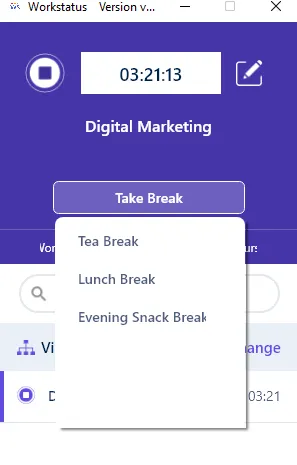
Employees can schedule breaks after working for any specific amount of time.
For instance, employees might take an hour-long lunch break after four hours without needing to clock in or out separately for each break.
Benefits of automatic break rules:
Accuracy improvement: Workstatus reduces employee mistakes when recording break times by automating breaks. It ensures accurate tracking of hours worked without human errors.
Enhanced transparency: Employees always know the number and duration of breaks they have taken during their workday. This transparency helps employees understand and follow break schedules more efficiently.
Why it matters:
Ensuring that breaks are properly accounted for as break time and not working hours is crucial to complying with labor laws. Workstatus’s Automatic Break Rules feature not only aids in adhering to legal standards but also promotes fairness and transparency in managing employee break times.
2. Preventing buddy punching
Workstatus has three attendance software tools to prevent buddy punching at the workplace:
Selfies on Punch
Geofencing
- Selfies on punch
Workstatus offers a facial recognition tool called Selfies on Pun
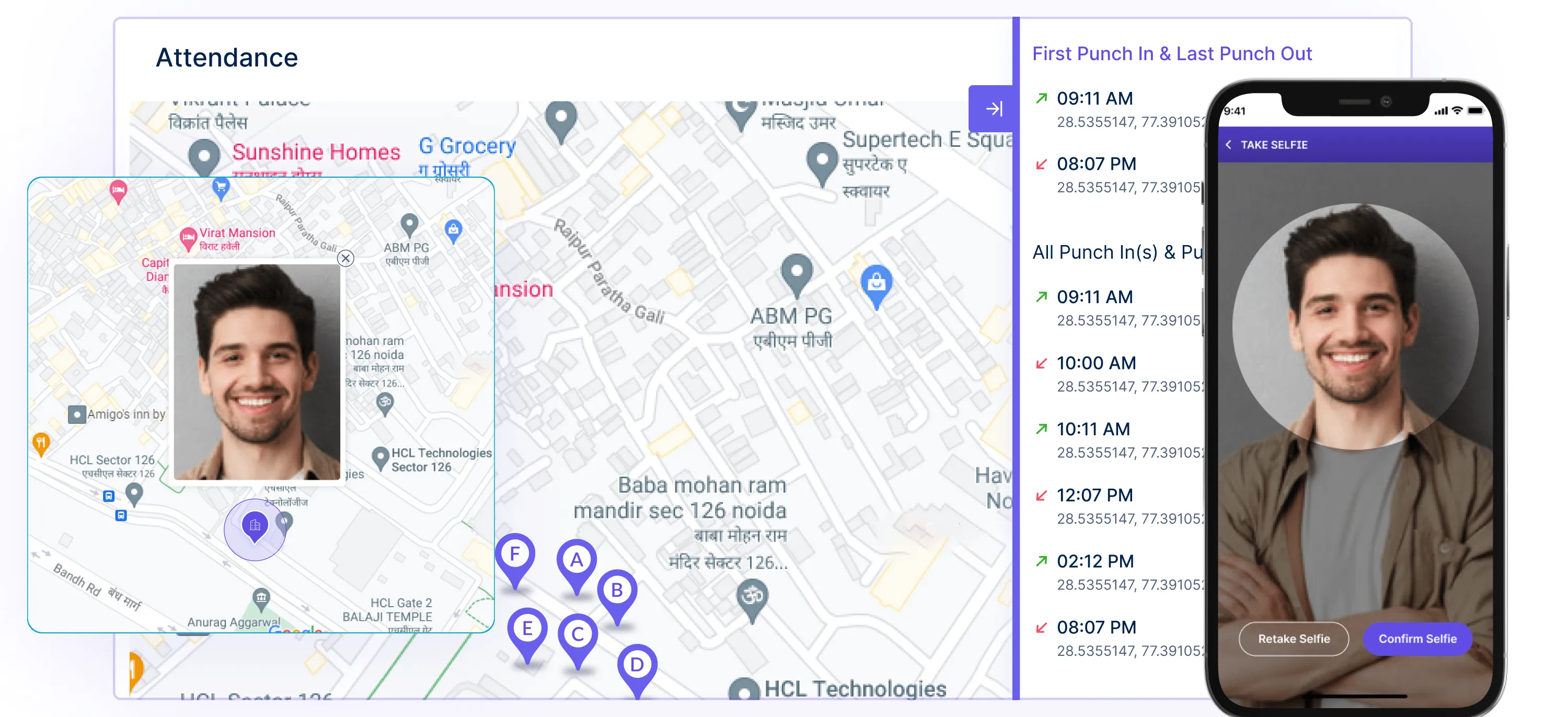
How selfies on punch works:
With Selfies on Punch, workers need to take a picture of themselves using their device’s camera (like their smartphone or tablet) when they clock in. This photo is then checked against the one already stored using facial recognition technology.
It ensures that only the right person can log in, even if they are working remotely.
- Geofencing
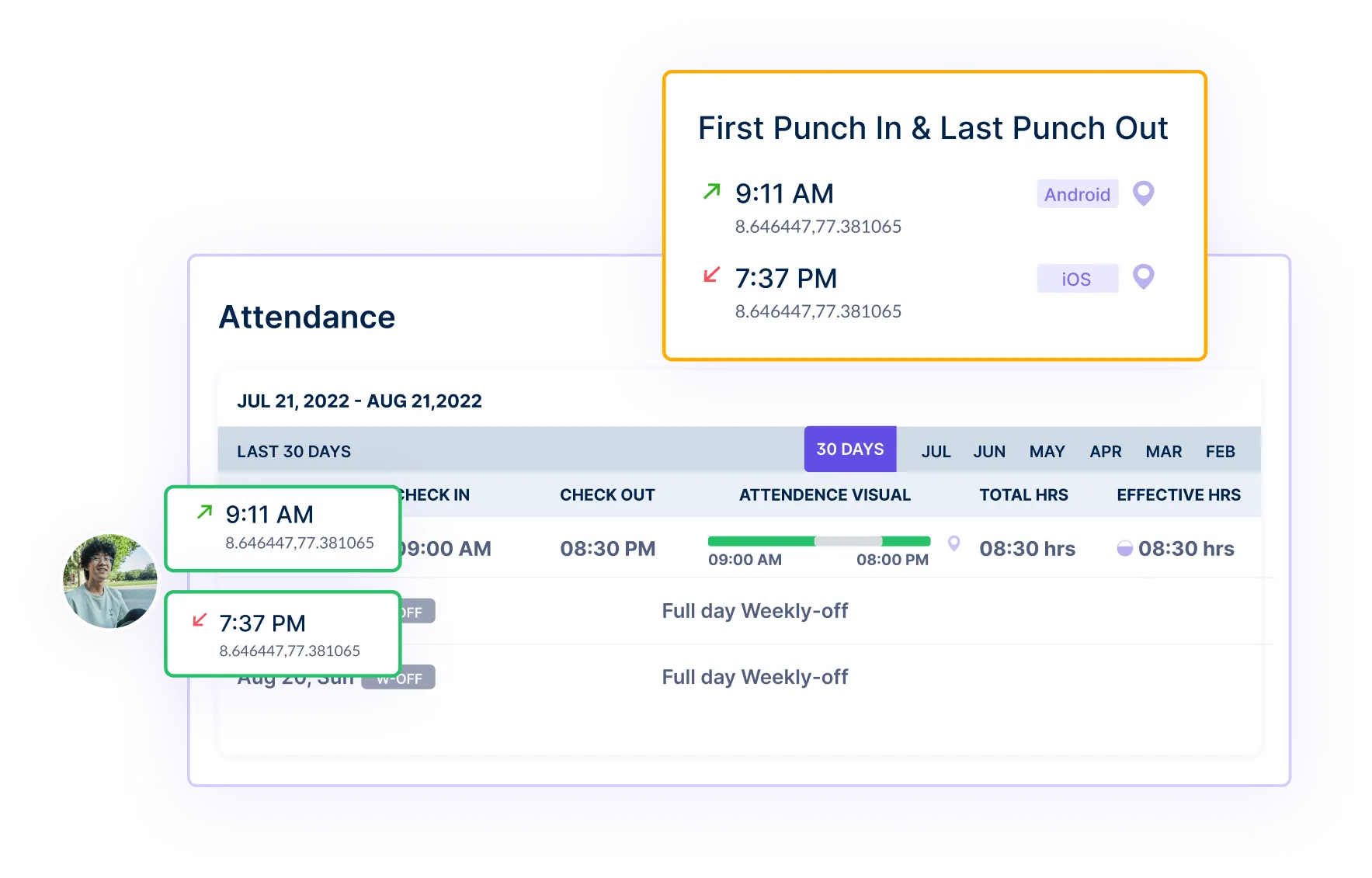
Geofencing is like drawing a virtual boundary around different work locations using GPS coordinates.
How geofencing works:
With Workstatus’ geofencing tool, you can set up GPS coordinates for various workplace spots and decide a specific area where employees should be present to clock in.
When employees try to clock in, the software checks if their GPS location matches the designated workplace area. If they’re outside that area, the software prompts them to try again when they are closer.
Why geofencing helps:
Geofencing discourages both buddy punching (when one person logs in for another) and absentee punching (when someone tries to clock in from far away). Each login attempt comes with GPS coordinates, ensuring employees are at the workplace when they clock in.
3. Limiting excessive personal internet use
Workstatus helps prevent excessive personal internet use during work hours by offering internet usage monitoring tools.
How Workstatus controls internet use:
Workstatus allows employers to monitor and limit employees’ time on personal internet activities during work hours. The software tracks the websites employees visit and the time spent on each site.
Features to Limit Personal Internet Use:
Website monitoring: Workstatus keeps an eye on employees’ websites, distinguishing between work-related and personal sites.
![]() Active screenshots: Active Screenshots capture images of employees’ computer screens regularly during work hours. These screenshots show what employees are working on and provide a visual record of their activities.
Active screenshots: Active Screenshots capture images of employees’ computer screens regularly during work hours. These screenshots show what employees are working on and provide a visual record of their activities.
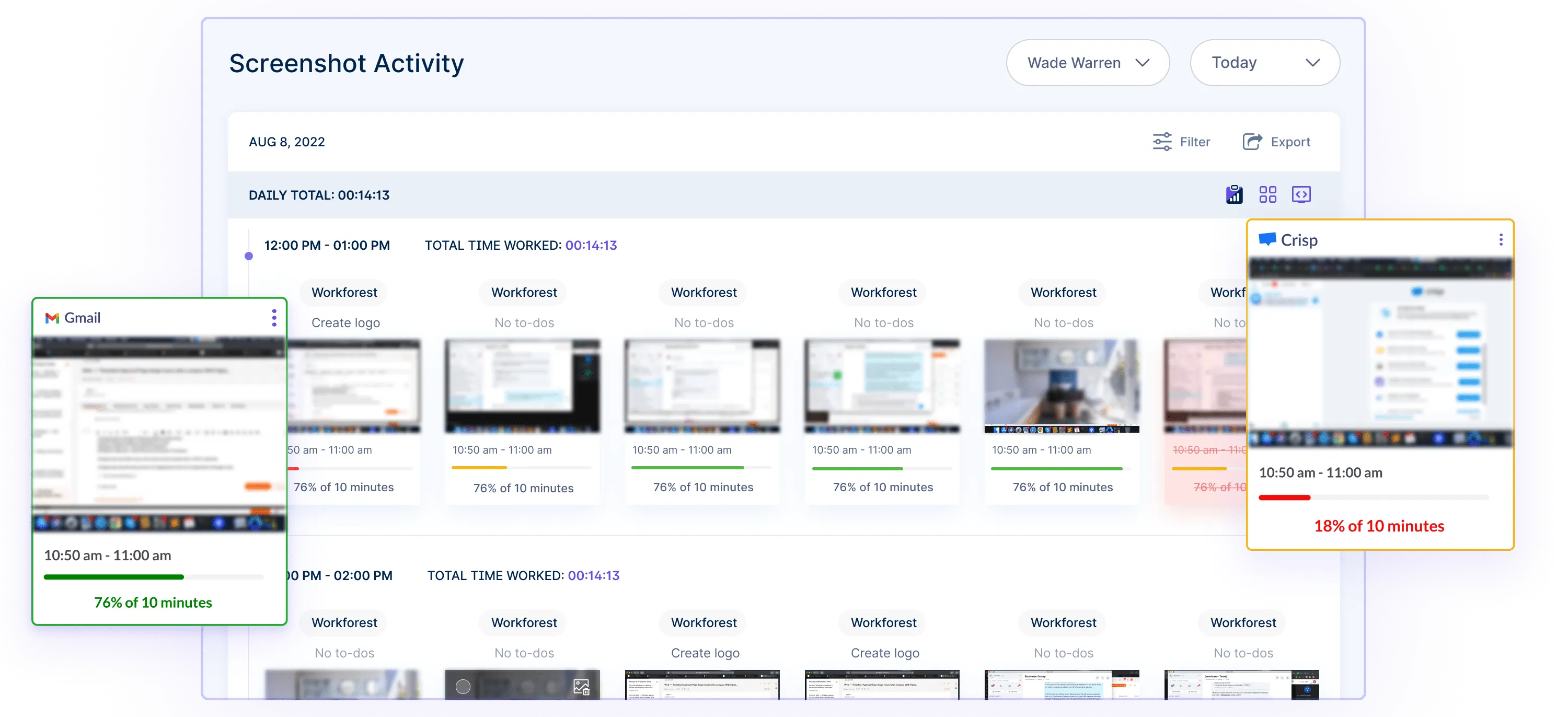
Benefits of Controlling Internet Use:
By monitoring internet usage, Workstatus helps employers ensure that employees focus on work-related tasks during work hours. This can improve productivity and reduce distractions caused by excessive personal internet use.
4. Avoiding Fake Timesheets
Workstatus helps prevent the creation of fake timesheets by implementing robust time tracking measures.
How Workstatus prevents fake timesheets:
Accurate time tracking: Workstatus ensures accurate time tracking by automatically recording and documenting employees’ work hours. This includes clock-in and clock-out times, breaks, and tasks performed during work hours.
Activity monitoring: The software tracks employees’ activities while logged in, providing insights into the work. This helps in verifying the accuracy of reported hours.
Features to prevent fake timesheets:
Real-Time Monitoring: Workstatus offers real-time monitoring of employee activities, making it difficult for employees to fabricate work hours.
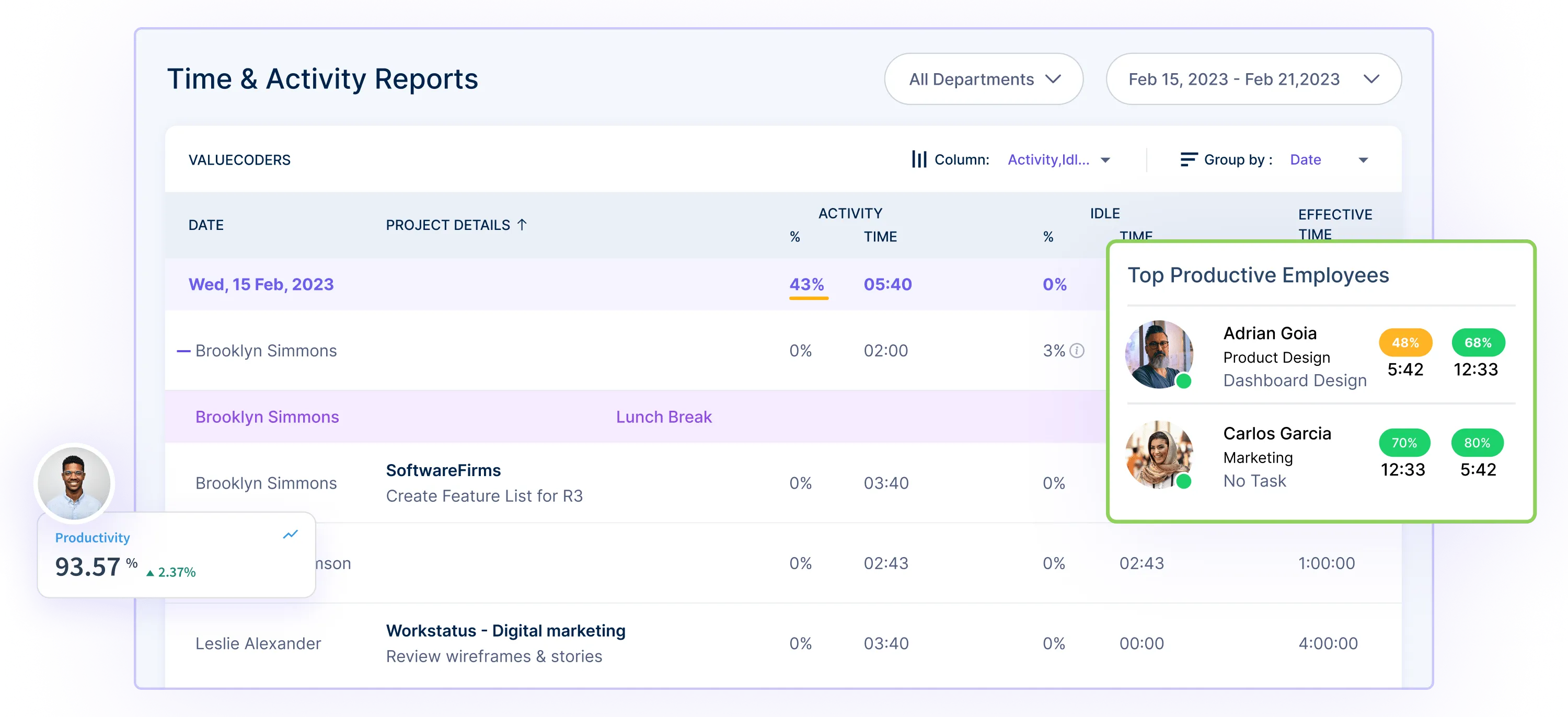
Timestamps and Audit Trails: The software generates timestamps and maintains audit trails of employees’ work activities, ensuring an accurate record of hours worked.
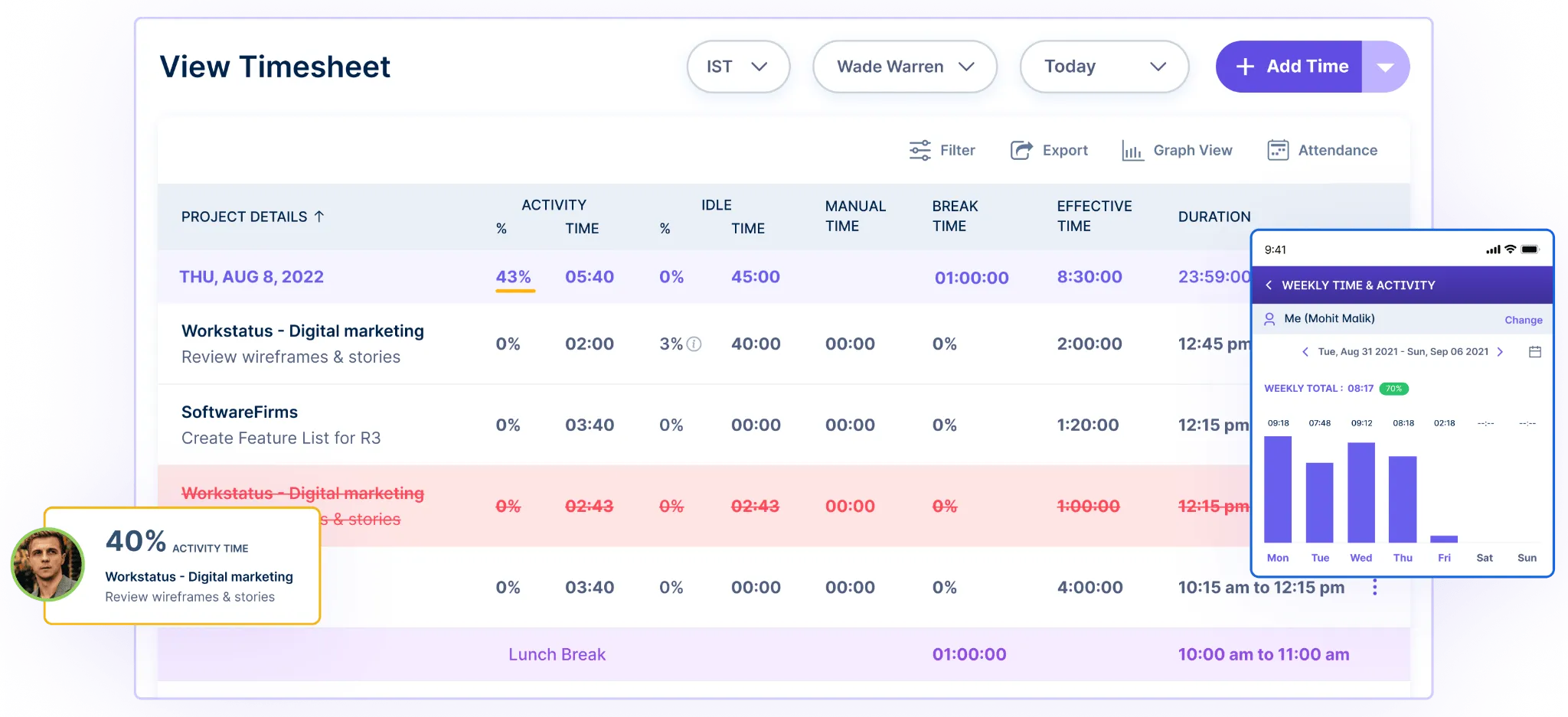
Benefits of preventing fake timesheets:
Ensured accuracy: Workstatus’ accurate time tracking features help maintain precise records of employee work hours, reducing the possibility of falsification.
Enhanced accountability: By discouraging fake timesheets, Workstatus promotes accountability among employees, ensuring fair compensation for actual work done.
Maintaining integrity:
Workstatus plays a crucial role in maintaining the integrity of timesheets by providing reliable and verifiable records of employees’ work hours, preventing falsification.
What Customers Are Saying
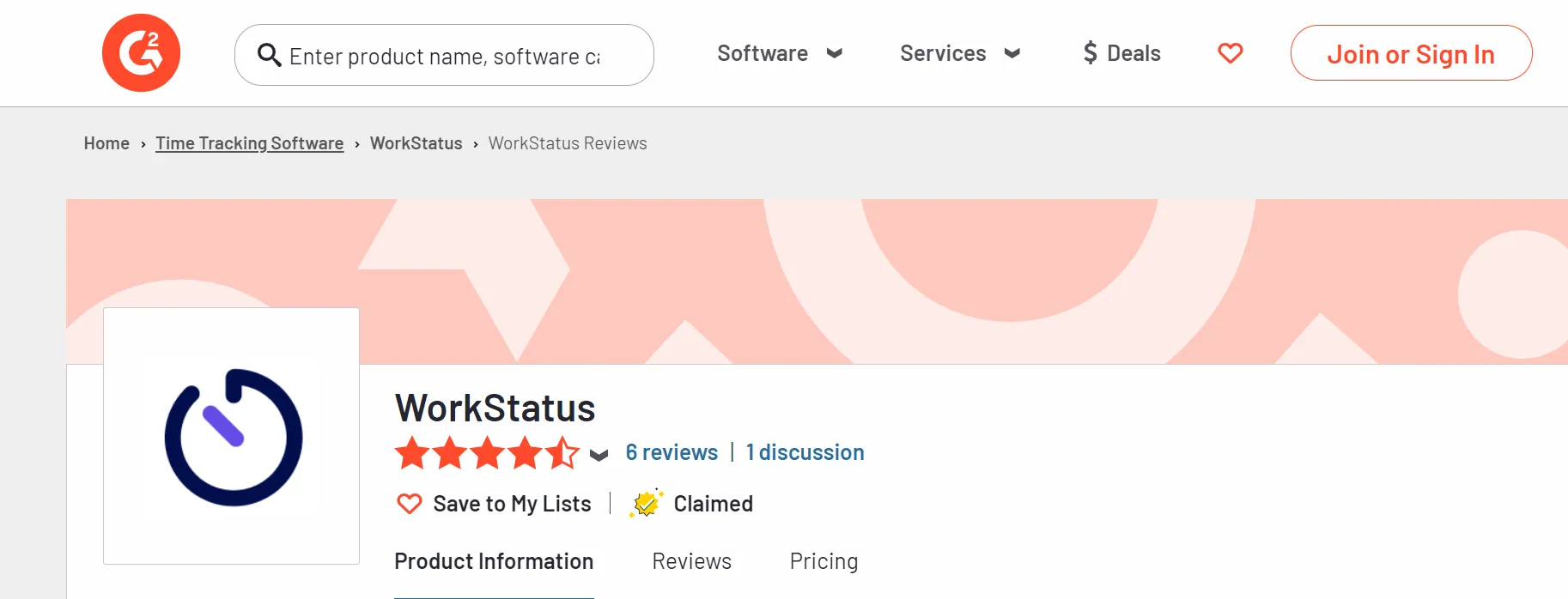
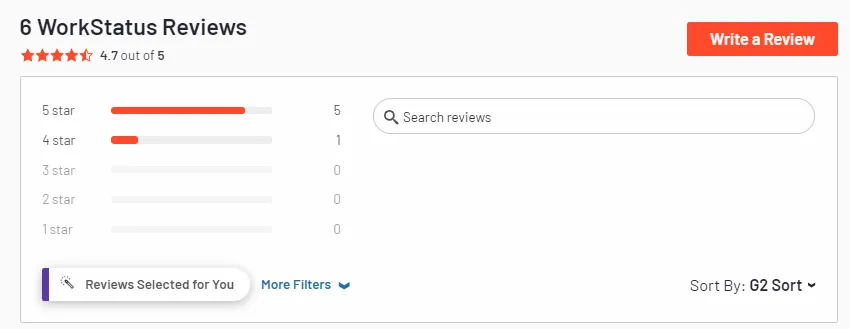
As of this writing, Workstatus has 4.7 out of 5 stars on G2 (a popular software review site).
Here’s What Our Clients Have To Say About Our Time Clock Software Tool:
“I used to handle everything on Google Sheets, but since switching to Workstatus, things have become much easier. It’s way more efficient, and the best part is, it helps keep my employees honest with their work hours.” – David Lee, Operations Supervisor
“The facial recognition feature on Workstatus is fantastic! It’s not just that; there are other cool features, all aimed at ensuring your staff is where they’re supposed to be when they clock in. It’s a great way to ensure everyone’s on the job site.” – Sarah Johnson, Store Manager
“We primarily rely on Workstatus for the time clock feature, but Workstatus’ GPS feature has been a game-changer for us. Our employees clock in and out from a remote site, and this feature accurately tracks their locations. It’s simple to use on their phones, and the accuracy is spot-on.” – Emily Rodriguez, HR Coordinator
You can see Workstatus’s G2 reviews here.
Closing Thoughts
In conclusion, time theft can lead to severe consequences for employees and employers.
It can harm the company’s productivity, finances, and trust among the team.
For employees, it risks damaging their reputation, leading to disciplinary actions, and affecting their work-life balance.
Preventing time theft is crucial to maintaining a fair and trustworthy work environment, ensuring productivity and a positive workplace for everyone involved.












